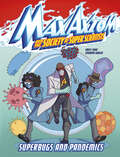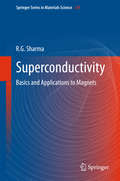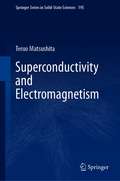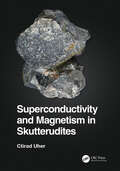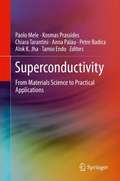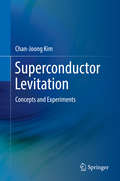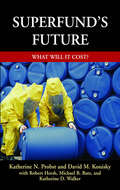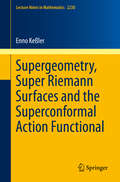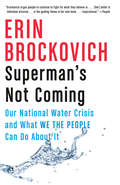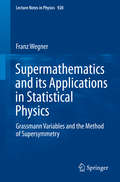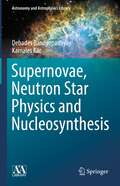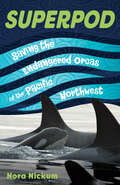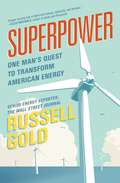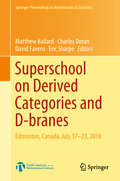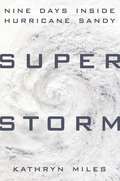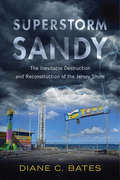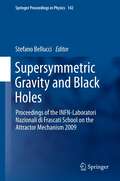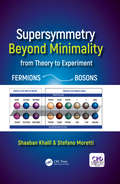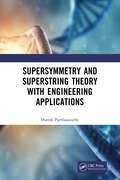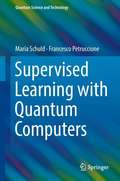- Table View
- List View
Superbugs and Pandemics: A Max Axiom Super Scientist Adventure (Max Axiom and the Society of Super Scientists)
by Emily SohnA new disease has reared its ugly head. People are getting very sick with high fevers and an itchy rash. Even worse, it seems to be spreading quickly to several major cities around the world. What is this new disease, and why is it spreading so fast? It’s up to Max Axiom and the Society of Super Scientists to find out! In this nonfiction graphic novel, young readers can follow the team as they go on an exciting, fact-filled adventure to learn how diseases work, why pandemics and superbugs are so dangerous, and things they can do to help stop the spread of deadly disease.
Superconductivity
by R. G. SharmaThis book presents the basics and applications of superconducting magnets. It explains the phenomenon of superconductivity, theories of superconductivity, type II superconductors and high-temperature cuprate superconductors. The main focus of the book is on the application to superconducting magnets to accelerators and fusion reactors and other applications of superconducting magnets. The thermal and electromagnetic stability criteria of the conductors and the present status of the fabrication techniques for future magnet applications are addressed. The book is based on the long experience of the author in studying superconducting materials, building magnets and numerous lectures delivered to scholars. A researcher and graduate student will enjoy reading the book to learn various aspects of magnet applications of superconductivity. The book provides the knowledge in the field of applied superconductivity in a comprehensive way.
Superconductivity and Electromagnetism (Springer Series in Solid-State Sciences #195)
by Teruo MatsushitaThis book introduces readers to the characteristic features of electromagnetic phenomena in superconductivity. It first demonstrates not only that the diamagnetism in the superconductivity complies with Maxwell’s theory, which was formulated before the discovery of superconductivity, but also that the dominant E-B analogy in the electromagnetism loses perfection without the superconductivity. The book then explores flux pinning, which is responsible for the non-dissipative current in DC, leading to irreversibility in AC. Drawing on Maxwell’s work, it also proves theoretically that if there is no energy dissipation in the superconductivity caused by the break in time reversal symmetry, it contradicts the thermodynamic principle of energy conservation – something that had previously only been proved experimentally.Lastly, the book addresses the longitudinal magnetic field effect, and explains how this phenomenon leads to a new development of Maxwell’s theory. Featuring numerous appendices to help readers understand the methods of derivation of equations, this book offers students and young scientists an introduction to applied superconductivity, especially in the context of power applications. Presenting the characteristic features of electromagnetic phenomena in superconductivity from basic to advanced topics for applications, the book offers a valuable resource for graduate students and researchers studying superconductivity as well as engineers working in electric utility industry.
Superconductivity and Magnetism in Skutterudites
by Ctirad UherSuperconductivity and Magnetism in Skutterudites discusses superconducting and magnetic properties of a class of materials called skutterudites. With a brief introduction of the fundamental structural features of skutterudites, the book then provides a detailed assessment of the superconducting and magnetic properties, focusing particularly on the rare earth-filled skutterudites where a plethora of fascinating properties and ground states is realized due to interactions of the filler species with the framework ions. Such interactions underpin the exciting forms of superconductivity and magnetism, most notably realized in the exotic heavy fermion superconductor of composition PrOs4Sb12. The two main topics of superconductivity and magnetism are provided with a concise introduction of superconducting and magnetic properties so that a reader can appreciate and understand the main arguments in the text. This book would appeal to graduate students, postdoctoral students, and anyone interested in superconducting and magnetic properties of a large family of minerals called skutterudites. Key Features:• Gives a thorough account of the superconducting and magnetic properties of skutterudites. • Each topic is accompanied by introductory sections to assist in the understanding of the text. • Supported by numerous figures and all key references.
Superconductivity: From Materials Science to Practical Applications
by Paolo Mele Tamio Endo Anna Palau Kosmas Prassides Chiara Tarantini Petre Badica Alok K. JhaThis book provides readers with a comprehensive overview of the science of superconducting materials. It serves as a fundamental information source on the actual techniques and methodologies involved in superconducting materials growth, characterization and processing. This book includes coverage of several categories of medium and high-temperature superconducting materials: cuprate oxides, borides, and iron-based chalcogenides and pnictides. Provides a single-source reference on superconducting materials growth, characterization and processing;Bridges the gap between materials science and applications of superconductors;Discusses several categories of superconducting materials such as cuprate oxides, borides, and iron-based chalcogenides and pnictides;Covers synthesis, characterization, and processing of superconducting materials, as well as the nanoengineering approach to tailor the properties of the used materials at the nanoscale level.
Superconductor Levitation: Concepts and Experiments
by Chan-Joong KimThis book introduces the physical principles behind levitation with superconductors, and includes many examples of practical magnetic levitation demonstrations using superconducting phenomena. It features more than twenty examples of magnetic levitation in liquid nitrogen using high temperature superconductors and permanent magnets, all invented by the author. The book includes the demonstration of suspension phenomenon induced by magnetic flux pinning as well as magnetic levitation by the Meissner effect. It shows how superconducting magnetic levitation and suspension phenomena fire the imagination and provide scientific insight and inspiration. This book will be a useful experimental guide and teaching resource for those working on superconductivity, and a fascinating text for undergraduate and graduate students.
Superfund And Mining Megasites: Lessons From The Coeur D'alene River Basin
by National Research Council of the National AcademiesFor more than 100 years, the Coeur d' Alene River Basin has been known as "The Silver Valley" for being one of the most productive silver, lead, and zinc mining areas in the United States. Over time, high levels of metals (including lead, arsenic, cadmium, and zinc) were discovered in the local environment and elevated blood lead levels were found in children in communities near the metal-refining and smelter complex. In 1983, the U.S. Environmental Protection Agency (EPA) listed a 21-square mile mining area in northern Idaho as a Superfund site. EPA extended those boundaries in 1998 to include areas throughout the 1500-square mile area Coeur d'Alene River Basin project area. Under Superfund, EPA has developed a plan to clean up the contaminated area that will cost an estimated $359 million over 3 decades--and this effort is only the first step in the cleanup process. Superfund and Mining Megasites: Lessons from Coeur d'Alene River Basin evaluates the issues and concerns that have been raised regarding EPA's decisions about cleaning up the area. The scientific and technical practices used by EPA to make decisions about human health risks at the Coeur d'Alene River Basin Superfund site are generally sound; however, there are substantial concerns regarding environmental protection decisions, particularly dealing with the effectiveness of long-term plans.
Superfund's Future: What Will It Cost
by Katherine ProbstReauthorization of the Superfund law continues to be a major source of controversy among political leaders and environmental activists. Some seek a major overhaul of the statute, arguing that considerable cleanup still needs to be done. Others oppose major changes, asserting that cleanup is almost complete. One of the most contentious issues in the debate is whether the taxes that once stocked the Superfund Trust Fund need to be reinstated. The answer depends in large part on how much money EPA will need to implement the Superfund program. To inform this discussion, the U.S. Congress asked Resources for the Future (RFF) to estimate the program's future costs. The results of this research are included in Superfund's Future, a book that will become an essential reference for all participants in the debate about one of the nation's most controversial environmental programs.
Supergeometry, Super Riemann Surfaces and the Superconformal Action Functional (Lecture Notes in Mathematics #2230)
by Enno KeßlerThis book treats the two-dimensional non-linear supersymmetric sigma model or spinning string from the perspective of supergeometry. The objective is to understand its symmetries as geometric properties of super Riemann surfaces, which are particular complex super manifolds of dimension 1|1.The first part gives an introduction to the super differential geometry of families of super manifolds. Appropriate generalizations of principal bundles, smooth families of complex manifolds and integration theory are developed.The second part studies uniformization, U(1)-structures and connections on Super Riemann surfaces and shows how the latter can be viewed as extensions of Riemann surfaces by a gravitino field. A natural geometric action functional on super Riemann surfaces is shown to reproduce the action functional of the non-linear supersymmetric sigma model using a component field formalism. The conserved currents of this action can be identified as infinitesimal deformations of the super Riemann surface. This is in surprising analogy to the theory of Riemann surfaces and the harmonic action functional on them.This volume is aimed at both theoretical physicists interested in a careful treatment of the subject and mathematicians who want to become acquainted with the potential applications of this beautiful theory.
Superman's Not Coming: Our National Water Crisis and What We the People Can Do About It
by Erin BrockovichFrom the environmental activist, consumer advocate, renowned crusader, and champion fighter whose courageous case against Pacific Gas and Electric was dramatized in the Oscar-winning film—a book to inspire change that looks at our present situation with water and reveals the imminent threats to our most precious, essential element as it shows us how, in large and practical ways, we can each take action to make changes in our cities, our towns, and our villages before it is too late. In Erin Brockovich&’s long-awaited book—her first to reckon with conditions on our planet—she makes clear why we are in the trouble we&’re in and warns us that if we&’re waiting for someone to save us, Superman isn&’t coming. Nor is the government or the environmental agencies. No one is going to solve this for us. It is up to us, we the people, and Brockovich shows us how. She shows us what&’s at stake (the average American uses nearly one hundred gallons of water each day, for everything from drinking to cooking to bathing), writing of the unreported cancer clusters, of plastic pollutants in our tap water (we produce more than three hundred million tons annually of plastic in the world, and half of all plastics created for disposable items such as water bottles), of the fraudulent science that disguises these issues. She identifies and describes the most toxic chemicals in everyday products, from shampoos and baby lotions to cell phones and Tupperware, with only a few hundred under regulation, among them asbestos, lead, mercury, radon, and formaldehyde. She describes the saga of PG&E that continues to this day, and how her work in Hinckley, California, far from being a oneoff situation, opened up a rabbit hole bigger than anyone could have imagined, leading Brockovich to all of our backyards. We see the communities and people with whom she has worked and who have helped to make an impact: the water operator in Poughkeepsie, New York, who changed his system to create some of the safest water in the country; the moms in Hannibal, Missouri, who became the first citizens in the nation to file an ordinance prohibiting the use of ammonia in their public drinking water; the woman in Tonganoxie (Tongie), Kansas, who fought to keep a massive, $320 million Tyson chicken processing complex out of her town (population: 5,300). Throughout, Brockovich, ever inspiring, empowers us, urging us to act on what we know is right: to ask questions, to scrutinize our water professionals; showing us ways to protect our health, our families, and our lives; to storm our city halls, to use local media, town hall meetings, etc., until our water is safe for everyone to drink. Whether we have PhDs, or degrees in science or in law; whether we&’re politicians, or government or agency officials, Brockovich shows us how we can each take baby steps to make a difference that can, and will, and must change the world.
Supermathematics and its Applications in Statistical Physics
by Franz WegnerThis text presents the mathematical concepts of Grassmannvariables and the method of supersymmetry to a broad audience of physicistsinterested in applying these tools to disordered and critical systems, as wellas related topics in statistical physics. Based on many courses and seminarsheld by the author, one of the pioneers in this field, the reader is given asystematic and tutorial introduction to the subject matter. The algebra and analysis of Grassmann variables ispresented in part I. The mathematics of these variables is applied to a randommatrix model, path integrals for fermions, dimer models and the Ising model intwo dimensions. Supermathematics - the use of commuting and anticommutingvariables on an equal footing - is the subject of part II. The properties ofsupervectors and supermatrices, which contain both commuting and Grassmanncomponents, are treated in great detail, including the derivation of integraltheorems. In part III, supersymmetric physical models are considered. Whilesupersymmetry was first introduced in elementary particle physics as exactsymmetry between bosons and fermions, the formal introduction of anticommutingspacetime components, can be extended to problems of statistical physics, and,since it connects states with equal energies, has also found its way intoquantum mechanics. Several models are considered in the applications, afterwhich the representation of the random matrix model by the nonlinearsigma-model, the determination of the density of states and the levelcorrelation are derived. Eventually, the mobility edge behavior is discussedand a short account of the ten symmetry classes of disorder, two-dimensionaldisordered models, and superbosonization is given.
Supernovae, Neutron Star Physics and Nucleosynthesis (Astronomy and Astrophysics Library)
by Debades Bandyopadhyay Kamales KarThis book deals with the interdisciplinary areas of nuclear physics, supernovae and neutron star physics. It addresses the physics and astrophysics of the spectacular supernova explosions, starting with the collapse of massive stars and ending with the birth of neutron stars or black holes. Recent progress in the understanding of core collapse supernova (CCSN) and observational aspects of future detections of neutrinos from CCSN explosions are discussed. The other main focus in this text is the novel phases of dense nuclear matter, its compositions and equation of state (EoS) from low to very high baryon density relevant to supernovae and neutron stars. The multi-messenger astrophysics of binary neutron star merger GW170817 and its relation to EoS through tidal deformability are also presented in detail. The synthesis of elements heavier than iron in the supernova and neutron star environment by the rapid (r)-process are treated here with special emphasis on the nucleosynthesis in the ejected material from GW170817. This monograph is written for graduate students and researchers in the field of nuclear astrophysics.
Superpod: Saving the Endangered Orcas of the Pacific Northwest
by Nora NickumMeet the playful and beloved Southern Resident orcas and the people working to save them from extinction using tactics that vary from medicine and laws to drones and dogs The endangered Southern Resident orcas whistle and click their way around the waters of the Pacific Northwest in three small family groups while facing boat noise, pollution, and scarce food. Superpod introduces young readers to the experts who are training scat-sniffing dogs, inventing ways to treat sick orcas, quieting the waters, studying whales from the air, and speaking out. Author Nora Nickum also discusses her own work on laws to protect the orcas, tackles the dark history of orca capture for marine parks, and shares moments of wonder. Readers can dive in to help save these majestic orcas with diverse action ideas and to find inspiration for a wide range of future careers.
Superpower Dogs
by CosmicMeet the real-life superheroes who walk--and bark--among us in this stunning photographic picture book featuring the stars of the IMAX film Superpower Dogs! Every single day, dogs around the world use their amazing abilities to help save lives. In over fifty dynamic photos and a fun, fact-filled text, meet some of the incredible canines who save lives, fight crime, and help people heal. Superpower Dogs is a fun and inspiring read for animal lovers of all ages, celebrating the remarkable work of heroic dogs.
Superpower Dogs: Avalanche Rescue Dog
by CosmicJoin Henry, one of the stars of the IMAX film Superpower Dogs, as he emBARKS on a journey to become an avalanche rescue dog in this gripping true story, perfect for fans of Max! In Whistler, British Columbia, dogs can be found riding chairlifts, perched on skiers' shoulders, and even descending from helicopters--all in the race against time to save people caught in the path of an avalanche. Meet Henry, a lovable border collie, and the team of dogs and human partners he works with in the beautiful and sometimes dangerous mountains. Through the action-packed narrative, informative and engaging interstitials, and eight pages of stunning full-color photographs, young readers will experience real-life rescues and gain a new appreciation for the bond between dogs and humans.
Superpower Dogs: Disaster Response Dog
by CosmicJoin Halo, one of the stars of the IMAX film Superpower Dogs, as she emBARKS on a journey to become a disaster response dog in this gripping nonfiction story, perfect for fans of Max! Dutch Shepherd puppy Halo has spent almost her whole life preparing for one job: finding people who are trapped in disaster zones. Her bond with her human partner, Fire Captain Cat, is unshakeable, and together, they can overcome any obstacle. But training to be an Urban Search and Rescue dog is tough, and it's going to take all of Cat's dedication and Halo's courage to succeed. Enhanced with breathtaking photographs and amazing canine facts, this true story of a hero's journey from adorable puppy to skilled Urban Search and Rescue dog is proof that real life superheroes walk--and bark--among us.
Superpower: One Man's Quest to Transform American Energy
by Russell GoldIn the ever more urgent quest for sources of renewable energy, meet the man boldly harnessing the natural forces that could power America’s future.The United States is in the midst of an energy transition. We want to embrace renewable energy sources like wind and solar, and rely less on dirty fossil fuels. We don’t want to keep pumping so many heat-trapping gases into the atmosphere. Any transition from a North American power grid that uses mostly fossil fuels to one that is predominantly clean requires a massive building spree—billions of dollars’ worth. Enter Michael Skelly, an infrastructure builder who began working on wind energy in 2000, when many considered the industry a joke. Eight years later, Skelly helped create the second largest wind power company in the United States—which was sold for $2 billion. Wind energy was no longer funny; it was well on its way to generating a substantial percentage of the electricity in the United States. Acclaimed journalist and author of The Boom, “the best all-around book yet on fracking” (San Francisco Chronicle), Russell Gold tells the story of this pioneer whose innovations, struggles, and persistence represent the groundbreaking changes underway in American energy. InSuperpower, we meet Skelly’s financial backers, a family that pivoted from oil exploration to renewable energy; the farmers ready to embrace the new “cash crop”; the landowners prepared to go to court to avoid looking at overhead wires; and utility executives who concoct fiendish ways to block renewable energy. Gold also shows how Skelly’s innovative company, Clean Line Energy, conceived the idea for a new power grid that would allow sunlight where abundant to light up homes thousands of miles away in cloudy states, and take wind from the Great Plains to keep air conditioners running in Atlanta. Thrilling, provocative, and important, Superpower is a fascinating look at America’s future.
Superquake!: Why Earthquakes Occur and When the Big One Will Hit Southern California
by David RitchieIt's coming, sometime within your lifetime, as inexorably as approaching thunder--the biggest earthquake to hit the West Coast since San Francisco was demolished in 1906. This time the target most likely will be southern California and the sprawling, populous city of Los Angeles. And this time the devastation will be greater than ever before, because in the eighty-odd years since the last great quake we have become so much more dependent on our technology. It won't be just toppled buildings and broken roads this time, but the complete disruption of transportation and communication systems, the breakdown of medical services, the destruction of water resources, widespread spilling of toxic chemicals and volatile fuels, and the leakage of radioactive materials. Angelenos can forget about the bomb; they are building their future in the shadow of an equally destructive and much more inevitable catastrophe. Science writer David Ritchie takes a hard look at the evidence predicting a devastating earthquake for southern California sometime within the next fifty years. What causes earthquakes, and how can earth scientists be so certain that a major earthquake is coming? Ritchie surveys the history of California quakes and shows that, while individual generations of Californians may escape catastrophe, on a geologic time scale the West Coast is highly unstable and ripe for disaster.
Superschool on Derived Categories and D-branes: Edmonton, Canada, July 17-23, 2016 (Springer Proceedings in Mathematics & Statistics #240)
by Matthew Ballard Charles Doran David Favero Eric SharpeThis book consists of a series of introductory lectures on mirror symmetry and its surrounding topics. These lectures were provided by participants in the PIMS Superschool for Derived Categories and D-branes in July 2016. Together, they form a comprehensive introduction to the field that integrates perspectives from mathematicians and physicists alike. These proceedings provide a pleasant and broad introduction into modern research topics surrounding string theory and mirror symmetry that is approachable to readers new to the subjects. These topics include constructions of various mirror pairs, approaches to mirror symmetry, connections to homological algebra, and physical motivations. Of particular interest is the connection between GLSMs, D-branes, birational geometry, and derived categories, which is explained both from a physical and mathematical perspective. The introductory lectures provided herein highlight many features of this emerging field and give concrete connections between the physics and the math.Mathematical readers will come away with a broader perspective on this field and a bit of physical intuition, while physicists will gain an introductory overview of the developing mathematical realization of physical predictions.
Superstorm
by Kathryn MilesThe first complete moment-by-moment account of the largest Atlantic storm system ever recorded--a hurricane like no other The sky was lit by a full moon on October 29, 2012, but nobody on the eastern seaboard of the United States could see it. Everything had been consumed by cloud. The storm's immensity caught the attention of scientists on the International Space Station. Even from there, it seemed almost limitless: 1.8 million square feet of tightly coiled bands so huge they filled the windows of the Station. It was the largest storm anyone had ever seen. Initially a tropical storm, Sandy had grown into a hybrid monster. It charged across open ocean, picking up strength with every step, baffling meteorologists and scientists, officials and emergency managers, even the traditional maritime wisdom of sailors and seamen: What exactly was this thing? By the time anyone decided, it was too late. And then the storm made landfall. Sandy was not just enormous, it was also unprecedented. As a result, the entire nation was left flat-footed. The National Oceanic and Atmospheric Administration couldn't issue reliable warnings; the Coast Guard didn't know what to do. In Superstorm, journalist Kathryn Miles takes readers inside the maelstrom, detailing the stories of dedicated professionals at the National Hurricane Center and National Weather Service. The characters include a forecaster who risked his job to sound the alarm in New Jersey, the crew of the ill-fated tall ship Bounty, Mayor Bloomberg, Governor Christie, and countless coastal residents whose homes--and lives--were torn apart and then left to wonder . . . When is the next superstorm coming?
Superstorm Sandy
by Diane C. BatesSandy was the costliest hurricane in U.S. history after Katrina, but the waters had barely receded from the Jersey coast when massive efforts began to "Restore the Shore." Why do people build in areas open to repeated natural disasters? And why do they return to these areas in the wake of major devastation? Drawing on a variety of insights from environmental sociology, Superstorm Sandy answers these questions as it looks at both the unique character of the Jersey Shore and the more universal ways that humans relate to their environment. Diane C. Bates offers a wide-ranging look at the Jersey Shore both before and after Sandy, examining the many factors--such as cultural attachment, tourism revenues, and governmental regulation--that combined to create a highly vulnerable coastal region. She explains why the Shore is so important to New Jerseyans, acting as a key cultural touchstone in a state that lacks a central city or even a sports team to build a shared identity among the state's residents. She analyzes post-Sandy narratives about the Jersey Shore that trumpeted the dominance of human ingenuity over nature (such as the state's "Stronger than the Storm" advertising campaign) or proclaimed a therapeutic community ("Jersey Strong")--narratives rooted in emotion and iconography, waylaying any thought of the near-certainty of future storms. The book also examines local business owners, politicians, real estate developers, and residents who have vested interests in the region, explaining why the Shore was developed intensively prior to Sandy, and why restoration became an imperative in the post-storm period. Engagingly written and insightful, Superstorm Sandy highlights the elements that compounded the disaster on the Shore, providing a framework for understanding such catastrophes and preventing them in the future.
Supersymmetric Gravity and Black Holes
by Stefano BellucciThis book is based upon lectures presented in the summer of 2009 at the INFN-Laboratori Nazionali di Frascati School on Attractor Mechanism, directed by Stefano Bellucci. The symposium included such prestigious lecturers as S. Ferrara, G. Dall'Agata, J.F. Morales, J. Simón and M. Trigiante. All lectures were given at a pedagogical, introductory level, which is reflected in the specific "flavor" of this volume. The book also benefits from extensive discussions about, and the related reworking of, the various contributions. It is the fifth volume in a series of books on the general topics of supersymmetry, supergravity, black holes and the attractor mechanism.
Supersymmetry Beyond Minimality: From Theory to Experiment
by Shaaban Khalil Stefano MorettiSupersymmetry (SUSY) is one of the most important ideas ever conceived in particle physics. It is a symmetry that relates known elementary particles of a certain spin to as yet undiscovered particles that differ by half a unit of that spin (known as Superparticles). Supersymmetric models now stand as the most promising candidates for a unified theory beyond the Standard Model (SM). SUSY is an elegant and simple theory, but its existence lacks direct proof. Instead of dismissing supersymmetry altogether, Supersymmetry Beyond Minimality: from Theory to Experiment suggests that SUSY may exist in more complex and subtle manifestation than the minimal model. The book explores in detail non-minimal SUSY models, in a bottom-up approach that interconnects experimental phenomena in the fermionic and bosonic sectors. The book considers with equal emphasis the Higgs and Superparticle sectors, and explains both collider and non-collider experiments. Uniquely, the book explores charge/parity and lepton flavour violation. Supersymmetry Beyond Minimality: from Theory to Experiment provides an introduction to well-motivated examples of such non-minimal SUSY models, including the ingredients for generating neutrino masses and/or relaxing the tension with the heavily constraining Large Hadron Collider (LHC) data. Examples of these scenarios are explored in depth, in particular the discussions on Next-to-Minimal Supersymmetric SM (NMSSM) and B-L Supersymmetric SM (BLSSM).
Supersymmetry and Superstring Theory with Engineering Applications
by Harish ParthasarathyThis book introduces the vast subject of supersymmetry along with many specific examples of engineering applications, for example: • The design of quantum unitary gates using supersymmetric actions.• Bosonic and Fermionic noise in quantum systems using the Hudson-Parthasarathy quantum stochastic calculus.• Superstring theory applied to the quantum mechanics of neurons and supersymmetric quantum filtering theory which can, for example, be used to filter out the noise in a cavity resonator electromagnetic field produced by the presence electrons and positrons in a bath surrounding it.• Simplified versions of super-Yang-Mills theory with gauge and gaugino fields, both transforming under the adjoint representation of the gauge group and elementary super-gravity models have also been introduced. All through the book, emphasis is laid upon exploiting the supersymmetry existing in the nature of Boson-Fermion exchange in designing engineering systems like quantum computers and analyzing the performance of systems in the presence of supersymmetric quantum noise.
Supervised Learning with Quantum Computers (Quantum Science and Technology)
by Maria Schuld Francesco PetruccioneQuantum machine learning investigates how quantum computers can be used for data-driven prediction and decision making. The books summarises and conceptualises ideas of this relatively young discipline for an audience of computer scientists and physicists from a graduate level upwards. It aims at providing a starting point for those new to the field, showcasing a toy example of a quantum machine learning algorithm and providing a detailed introduction of the two parent disciplines. For more advanced readers, the book discusses topics such as data encoding into quantum states, quantum algorithms and routines for inference and optimisation, as well as the construction and analysis of genuine ``quantum learning models''. A special focus lies on supervised learning, and applications for near-term quantum devices.
